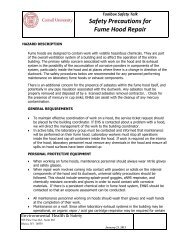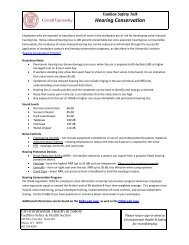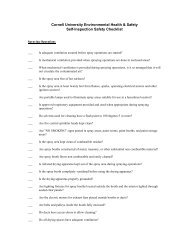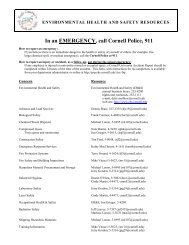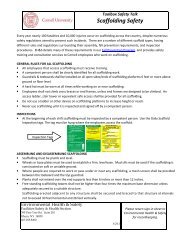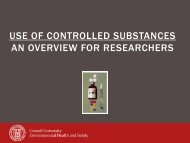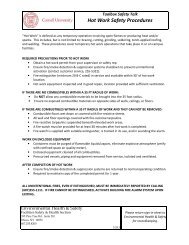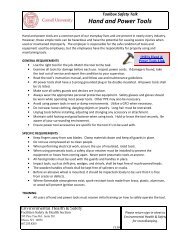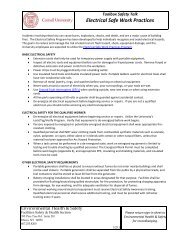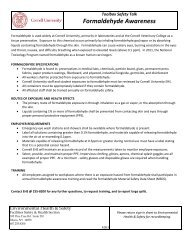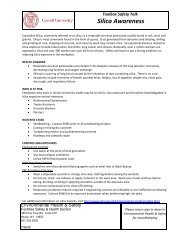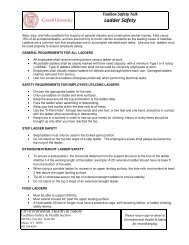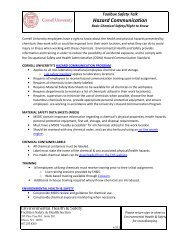Checklist for Biosafety Level 2 Laboratory Operations
Checklist for Biosafety Level 2 Laboratory Operations
Checklist for Biosafety Level 2 Laboratory Operations
- No tags were found...
You also want an ePaper? Increase the reach of your titles
YUMPU automatically turns print PDFs into web optimized ePapers that Google loves.
<strong>Checklist</strong> <strong>for</strong> <strong>Biosafety</strong> <strong>Level</strong> 2 <strong>Laboratory</strong> <strong>Operations</strong>Department ________________________________ Building __________________________ Room # ______________Principal Investigator _______________________________________<strong>Laboratory</strong> Contact ________________________________________Net ID _____________ Phone # ______________Net ID _____________ Phone # ______________IBC Member(s) Present ________________________________________________ Date Completed _________________The following statements are based primarily on the <strong>Biosafety</strong> <strong>Level</strong> 2 section of <strong>Biosafety</strong> in Microbiological andBiomedical Laboratories, 5 th edition, 2007 (http://www.cdc.gov/od/ohs/biosfty/bmbl5/bmbl5toc.htm). Check the appropriatebox <strong>for</strong> each statement. Please provide comments or an explanation <strong>for</strong> “No” or “NA” (Not Applicable) responses. Thischecklist may be used <strong>for</strong> in-house assessment or as part of a review completed by the Institutional <strong>Biosafety</strong> Committee.Contact the Biological Safety Officer (fac2@cornell.edu, 254-4888) if you have any questions or require assistance.A. Standard Microbiological Practices1. Access to the laboratory is limited or restricted at the discretion of the Principal Investigatoror laboratory supervisor when experiments are in progress.2. Personnel wash their hands after they handle viable materials and animals, after removinggloves, and be<strong>for</strong>e leaving the laboratory.3. Eating, drinking, handling contact lenses, and applying cosmetics are not permitted in thelaboratory. Persons who wear contact lenses in laboratories should also wear safety glasses,goggles or face shield. Food is stored outside the laboratory in cabinets or refrigeratorsdesignated <strong>for</strong> this purpose only.4. Mouth pipetting is prohibited; mechanical pipetting devices must be used.5. Policies <strong>for</strong> the safe handling of sharps, such as needles, scalpels, pipettes, and brokenglassware must be developed and implemented. Whenever practical, laboratory supervisorsshould adopt improved engineering and work practice controls that reduce risk of sharpsinjuries. Precautions, including those listed below, must always be taken with sharp items.These include:a. Careful management of needles and other sharps are of primary importance. Needlesmust not be bent, sheared, broken, recapped, removed from disposable syringes, orotherwise manipulated by hand be<strong>for</strong>e disposal.b. Used disposable needles and syringes must be carefully placed in convenientlylocated puncture-resistant containers used <strong>for</strong> sharps disposal.c. Non-disposable sharps must be placed in a hard walled sharps disposal containerused <strong>for</strong> sharps disposal.d. Broken glassware must not be handled directly. Instead, it must be removed using abrush and dustpan, tongs, or <strong>for</strong>ceps. Plasticware should be substituted <strong>for</strong> glasswarewhenever possible.Yes No NA 6. Per<strong>for</strong>m all procedures to minimize the creation of splashes or aerosols. 7. Decontaminate work surfaces and laboratory equipment routinely after completion of work,and after any spill or splash of potentially infections material with a disinfectant effectiveagainst the agents of concern. Contaminated equipment is decontaminated be<strong>for</strong>e removalfrom the facility, sent <strong>for</strong> repair or maintenance, or packaged <strong>for</strong> transport.8. Cultures, stocks, contaminated plasticware, and other regulated non-sharps wastes arediscarded in red biohazard bags and treated as regulated medical wastes (RMW). BSL2 <strong>Checklist</strong>, Version 2.5, February 2010 1 EH&S / IBC
9. Culture fluids and other contaminated liquid wastes are autoclaved or decontaminated with asuitable disinfectant be<strong>for</strong>e disposal down the sanitary drain.10. Materials to be decontaminated outside of the immediate laboratory are placed in a durable,leak-proof container and closed <strong>for</strong> transport from the laboratory.11. An effective integrated pest management program is required.12. A sign incorporating the universal biohazard symbol must be posted at the entrance to thelaboratory when infectious agents are present. Posted in<strong>for</strong>mation must include: thelaboratory’s biosafety level, the supervisor’s name (or other responsible personnel), telephonenumber, and required procedures <strong>for</strong> entering and exiting the laboratory.13. The laboratory supervisor must ensure that laboratory personnel receive appropriate trainingregarding their duties, the potential hazards associated with the work involved, the necessaryprecautions to prevent exposures, and exposure evaluation procedures (e.g., symptoms of adisease). Personnel must receive regular updates or additional training as necessary. Trainingis documented. Since personal health status may impact an individual’s susceptibility toinfection, ability to receive immunizations or prophylactic interventions, all laboratorypersonnel and particularly women of child-bearing age should be provided with in<strong>for</strong>mationregarding immune competence and conditions (e.g., chronic disease, medications) that maypredispose them to infection. Individuals having these conditions should be encouraged toself-identify to Occupational Medicine Gannett Health Services <strong>for</strong> appropriate counselingand guidance. Comments/Explanations <strong>for</strong> Standard Microbiological Practices________________________________________________________________________________________________________________________________________________________________________B. Special Practices1. All persons entering the laboratory must be advised of the potential hazards and meet specificentry/exit requirements.Yes No NA 2. <strong>Laboratory</strong> personnel must be provided medical surveillance and offered appropriateimmunizations <strong>for</strong> agents handled or potentially present in the laboratory.3. A laboratory-specific biosafety manual, standard operating procedures must be prepared andadopted as policy. The biosafety manual must be available and accessible.4. The laboratory supervisor must ensure that laboratory personnel demonstrate proficiency instandard and special microbiological practices be<strong>for</strong>e working with infectious agents.5. Potentially infectious materials must be placed in a durable, leak proof container duringcollection, handling, processing, storage, or transport within a facility.6. Incidents that may result in exposure to infectious materials must be immediately evaluatedand treated according to procedures described in the laboratory biosafety safety manual. Allsuch incidents must be reported to the laboratory supervisor and documented via theUniversity reporting system (http://prp.ehs.cornell.edu/Acc-Inj/). Medical evaluation,surveillance, and treatment should be provided by Occupational Medicine Gannett HealthServices or personal physician and appropriate records maintained.7. Projects that utilize biohazardous and/or recombinant DNA materials are registered with theInstitutional <strong>Biosafety</strong> Committee.8. Animals and plants not associated with the work being per<strong>for</strong>med must not be permitted in thelaboratory. BSL2 <strong>Checklist</strong>, Version 2.5, February 2010 2 EH&S / IBC
9. All procedures involving the manipulation of infectious materials that may generate anaerosol should be conducted within a biosafety cabinet (BSC) or other physical containmentdevices.10. On campus transport (between laboratories, buildings) of cultures, tissues, or specimens isconducted in closed, leak proof, break resistant containers, lined with absorbent material andlabeled with the biohazard sign and contact in<strong>for</strong>mation. Off campus transport must complywith domestic (US DOT) and/or international regulations (ICAO), including required training.11. Regulated medical wastes (pre-treated or untreated) are transported by self (if within the VetCollege) or EH&S to the CVM Waste Management Facility <strong>for</strong> final transport and disposal.12. Stock cultures of infectious agents are secured against unauthorized access (e.g., lockedfreezers, secured laboratories).13. Hypodermic syringes and needles, when not in use, are secured (e.g., locking cabinet, drawer)against unauthorized access. A log of stock materials and their distribution is maintained. ACertificate of Need from the NYS Department of Health is on file. Comments/Explanations <strong>for</strong> Special Practices________________________________________________________________________________________________________________________________________________________________________C. Safety Equipment (Primary Barriers)1. Properly maintained biological safety cabinets, preferably Class II, or other appropriatephysical containment devices must be used whenever:Yes No NAa. Procedures with a potential <strong>for</strong> creating infectious aerosols or splashes are conducted.These may include pipetting, centrifuging, grinding, blending, shaking or mixing,sonic disruption, opening containers of infectious materials whose internal pressuresmay be different from ambient pressures, intranasal inoculation of animals, andharvesting infected tissues from animals or eggs.b. High concentrations or large volumes of infectious agents are used. Such materialsmay be centrifuged in the open laboratory if sealed rotor heads, centrifuge safety cups,or gasket-containing centrifuge tubes are used. These rotors, safety cups, or tubes arepackaged and opened only in a biological safety cabinet.2. Biological safety cabinets are certified annually, when cabinets are moved, or when HEPAfilters are changed.3. Face protection (goggles, mask, face shield or other platter guards) is used <strong>for</strong> anticipatedsplashes or sprays of infectious or other hazardous materials to the face, when themicroorganisms must be manipulated outside the biological safety cabinet.4. Protective laboratory coats, gowns, smocks, or uni<strong>for</strong>ms designated <strong>for</strong> laboratory use must beworn while working with hazardous materials. Remove protective clothing be<strong>for</strong>e leaving <strong>for</strong>non-laboratory areas (e.g., cafeteria, library, administrative offices). Dispose of protectiveclothing appropriately, or deposit it <strong>for</strong> laundering by the institution. It is recommended thatlaboratory clothing not be taken home.5. Gloves must be worn to protect hands from exposure to hazardous materials. Glove selectionshould be based on an appropriate risk assessment. Alternatives to latex gloves should beavailable. Gloves must not be worn outside the laboratory. In addition, BSL-2 laboratoryworkers should:a. Change gloves when contaminated, integrity has been compromised, or whenotherwise necessary. Wear two pairs of gloves when appropriate. BSL2 <strong>Checklist</strong>, Version 2.5, February 2010 3 EH&S / IBC
. Remove gloves and wash hands when work with hazardous materials has beencompleted and be<strong>for</strong>e leaving the laboratory.c. Do not wash or reuse disposable gloves. Dispose of used gloves with othercontaminated laboratory waste. Hand washing protocols must be rigorouslyfollowed.6. Eye and face protection (goggles, mask, face shield or other splatter guard) is used <strong>for</strong>anticipated splashes or sprays of infectious or other hazardous materials when themicroorganisms must be handled outside the BSC or containment device. Eye and faceprotection must be disposed of with other contaminated laboratory waste or decontaminatedbe<strong>for</strong>e reuse. Persons who wear contact lenses in laboratories should also wear eye protection. Comments/Explanations <strong>for</strong> Safety Equipment________________________________________________________________________________________________________________________________________________________________________D. <strong>Laboratory</strong> Facilities (Secondary Barriers)1. Each laboratory must have a sink <strong>for</strong> hand washing. The sink may be manually, hands-free,or automatically operated. It should be located near the exit door.2 <strong>Laboratory</strong> doors should be self-closing and have locks in accordance with the institutionalpolicies.3. The laboratory should be designed so that it can be easily cleaned and decontaminated. Carpetsand rugs are not permitted.4. <strong>Laboratory</strong> furniture must be sturdy and capable of supporting anticipated loads and uses.Spaces between benches, cabinets, and equipment are accessible <strong>for</strong> cleaning.a. Bench tops must be impervious to water and resistant to moderate heat, acids, alkalis,organic solvents, and chemicals used to decontaminate the work surface.b. Chairs used in laboratory work must be covered with a non-porous material that canbe easily cleaned and decontaminated with appropriate disinfectant.5. BSCs must be installed so that fluctuations of the room air supply and exhaust do not interferewith proper operations. BSCs should be located away from doors, windows that can beopened, heavily traveled laboratory areas, supply and exhaust vents, and other possibleairflow disruptions.6. Vacuum lines should be protected with High Efficiency Particulate Air (HEPA) or theirequivalent. Liquid disinfectant traps may be required. Portable vacuum pumps may also beused (also properly protected with traps or filters).7. <strong>Laboratory</strong> windows that open to the exterior are not recommended. However, if a laboratorydoes have windows that open to the exterior, they must be fitted with screens.Yes No NA 8. <strong>Laboratory</strong> doors are kept closed whenever work with biohazardous materials is conducted. 9. An autoclave <strong>for</strong> pre-treatment of laboratory wastes is available. 10. An eyewash facility must be readily available within the laboratory. Comments/Explanations <strong>for</strong> <strong>Laboratory</strong> Facilities_______________________________________________________________________________________________________________________________________________________________________________________BSL2 <strong>Checklist</strong>, Version 2.5, February 2010 4 EH&S / IBC



